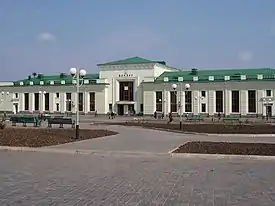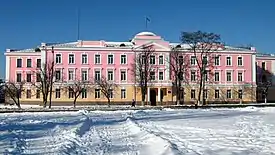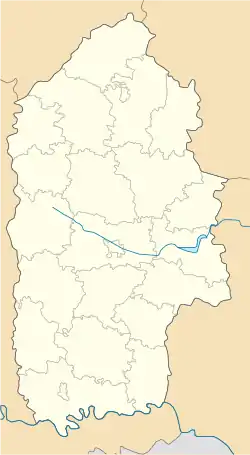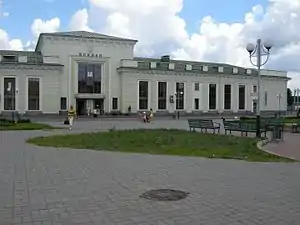Shepetivka
Shepetivka (Ukrainian: Шепеті́вка; Polish: Szepetówka, Russian: Шепето́вка, Shepetovka) is a town located on the Huska River in Khmelnytskyi Oblast (province) of Western Ukraine. Shepetivka is a town of oblast subordinance, and the administrative center of Shepetivskyi Raion (district). Population: 41,189 (2020 est.)[1]
Shepetivka
Шепетівка | |
|---|---|
   Shepetivka railway station, Museum of Propaganda, Shepetivka District Council | |
 Flag  Coat of arms | |
 Shepetivka Location of Shepetivka in Ukraine  Shepetivka Shepetivka (Ukraine) | |
| Coordinates: 50°11′0″N 27°04′0″E | |
| Country | |
| Oblast | |
| Raion | Shepetivskyi Raion |
| First mentioned | 1594 |
| Town rights | 1619 |
| Area | |
| • Total | 40 km2 (20 sq mi) |
| Population (2020) | |
| • Total | 41,189 |
| • Density | 1,199/km2 (3,110/sq mi) |
| Postal code | 30400 - 30409 |
| Area code(s) | +380 3840 |
| Website | www.shepetivka.com.ua |
Shepetivka is an important railway junction with five intersecting transit routes. It is located 100 km away from Khmelnytskyi, the oblast's capital.
The city is located near historic city of Izyaslav, the center of Ruthenian Zasławski princely estate.
History
![]() Polish–Lithuanian Commonwealth 1594–1793 (occupation)
Polish–Lithuanian Commonwealth 1594–1793 (occupation)
![]() Russian Empire 1793–1917 (occupation)
Russian Empire 1793–1917 (occupation)
![]() Republic of Poland 1919–1920 (occupation)
Republic of Poland 1919–1920 (occupation)
![]() Soviet Ukraine 1920–1922
Soviet Ukraine 1920–1922
![]() Soviet Union 1922–1991 (occupation)
Soviet Union 1922–1991 (occupation)
![]() Nazi Germany 1941–1944 (occupation)
Nazi Germany 1941–1944 (occupation)
![]() Ukraine 1991–present
Ukraine 1991–present
A settlement called Shepetovka, belonging to the prince Ivan Zaslavsky, was first mentioned in a written document in 1594. In the 16th century Shepetivka didn't differ from other settlements of Volhynia. The settlement had a community and a windmill. It was given Magdeburg Rights at the end of the 16th century. This contributed the settlement's expansion and growing population. At the turn of the 16th and 17th centuries the peasantry was intensively enslaved. Population of Shepetivka also suffered from frequent attacks of the Crimean Tatars. Peasants and craftsmen responded to the feudal oppression with the revolt in 1591-1593, led by Krzysztof Kosiński, and the revolt in 1594-1596, led by Severyn Nalyvaiko. When during the Ukrainian war of liberation from Poland in July 1648 peasant-Cossack regiments of Maxym Kryvonis had conquered Polonne, the inhabitants of Shepetivka joined the troops. At the end of the 17th century Shepetivka became property of Lubomirski family, and in 1703, of the Sanguszko family. And at the end of the 18th century it became part of Iziaslav county, Volhynian Governorate. In 1866 Shepetivka became the capital of the county.
The first written mention of Shepetivka was in 1594. In 1795 it became part of Iziaslav County, Volhynian Governorate. The first railway station was built in 1873.
In 1923 it got the status of a town, becoming the capital of Shepetovka district. In 1932 it became the capital of Shepetivka Raion, Vinnytsia Oblast. In 1937 Shepetivka Raion became part of Kamianets-Podilskyi (since 1954 Khmelnytskyi) Oblast. In 1991, Ukraine became an independent state, and Shepetovka became part of the state (and the town name took on the Ukrainian variant of "Shepetivka").
Shepetovka was a town with extensive settlement by Jews, similar to the surrounding region.[2] There were 20,000 Jews counted in a census in the late 1670s, and 52,000 in the 1760s.[3] Several important rabbis were active in the region in the 1700s, including Rabbi Pinchas Shapira, who is buried in Shepetovka.[4] Significant emigration from Shepetovka occurred between 1880 and 1925.
During World War II, the Jewish population of Shepetovka was decimated. Hundreds of people were shot to death over the summer of 1941, and thousands more in the summer of 1942. Some number of Jews, however, survived the war because they had been evacuated to safety in Uzbekistan.[5]
Notable residents
- Valentina Matviyenko, governor of Saint Petersburg, was born in Shepetivka
- Ignacy Jan Paderewski, pianist, composer, and Polish prime minister, lived near Shepetivka as a child
- Nikolai Ostrovsky, Soviet writer, lived here during his childhood and adolescent years, author of classic novel How the Steel Was Tempered
- Rabbis Pinchas of Korets lived about 30 miles from Shepetivka, but died and is buried in Shepetivka
- Rabbi Shimshon of Shepetovka was a celebrated talmudist who emigrated to Palestine in 1799, where he is buried
- Rabbi Simcha Sheps, Rosh Yeshiva of Yeshiva Torah Vodaas grew up in Shepetivka (according to the Torah Vodaas Haggadah)
Gallery
 Church of Nativity in Shepetivka
Church of Nativity in Shepetivka Shepetivka museum
Shepetivka museum Palace of Justice
Palace of Justice.JPG.webp) Great Synagogue in Shepetivka
Great Synagogue in Shepetivka Shepetivka Railway Station
Shepetivka Railway Station A street in Shepetivka
A street in Shepetivka Moscow Patriarchate church
Moscow Patriarchate church City Hall
City Hall Museum of Propaganda
Museum of Propaganda Shepetivka park
Shepetivka park
References
- "Чисельність наявного населення України (Actual population of Ukraine)" (PDF) (in Ukrainian). State Statistics Service of Ukraine. Retrieved 30 September 2020.
- https://sites.google.com/view/shepetovka-descendants/home
- https://sites.google.com/view/shepetovka-descendants/history
- https://sites.google.com/view/shepetovka-descendants/history
- https://sites.google.com/view/shepetovka-descendants/history
External links
- The murder of the Jews of Shepetivka during World War II, at Yad Vashem website.